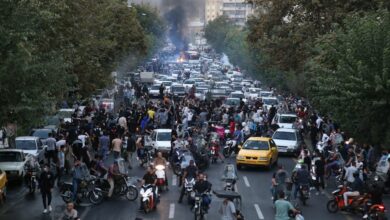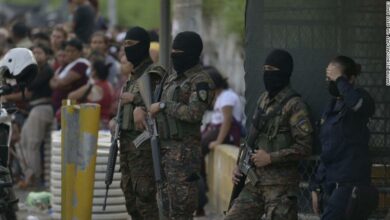The image became iconic; soon it was everywhere, in the papers, online. The look was kind, with a cocked half-smile, a look of contentment. It had an ethereal quality to it, which might only have been seen retrospectively because all who saw it knew that he had died. The juxtaposition with the other image was shocking – the contorted grimace and the smashed-in face.
Khaled Saeed died in Alexandria on 6 June, 2010, after being beaten to death by police officers in broad daylight. One year later, President Hosni Mubarak has been deposed and many of his top associates driven from power. Indeed, Saeed was one of the many inspirations for the revolution. His name is still sung out in chants at protests and his face an ever-present graffiti stencil. Yesterday it was sprayed on the wall of the Interior Ministry itself.
Hundreds took the streets in Cairo and Alexandria yesterday to commemorate the one-year anniversary of his death. The two policemen on trial for his murder are yet to be sentenced, with the verdict expected later this month.
Saeed was not the first person to die of torture at the hands of policemen in Egypt, nor was he the last, yet it was his story that resonated the most with the public, to the extent that thousands protested his death in the street, many of whom never participated in protests before.
Blogger and activist Mostafa Hussein, who at the time of Saeed’s death was a psychiatrist with El Nadeem Center for Rehabilitation of Victims of Violence and Torture, wrote 6 June on his blog, “I felt jealous about the response to Khaled Saeed's case. We had lots of other victims of torture who weren't dead who had gone through horrible experiences and were willing to speak about what happened to them.”
But Saeed resonated as the everyman, or at least every young man. Many saw the photos, heard the story and felt it could have been them.
“He was a regular person; he was apolitical, lived with his parents, went to an Internet café. And so for him to be killed in this horrendous way without having done anything, that’s what made the youth of Egypt feel that they were in danger from the thuggery of the Interior Ministry,” said Shadi al-Hussainy, 24, a translator protesting yesterday in front of the Ministry of Interior.
Saeed died after being taken into custody by two policemen in an Internet café in Sidi Gaber, Alexandria. The autopsy report released after his death stated that he had died from asphixiation after attempting to swallow a bag of hashish. Multiple witnesses, however, claimed the two policemen beat him to death inside a building opposite the café.
The photo that had been taken by his brother at the morgue lent credence to the claims of the eyewitnesses and had a profound effect on those who saw it, throwing into sharp relief the consequence of police brutality.
“I think the explicit images of this torture that were released had a big impact, and it was the first time the wider public saw what actually happens to people when they are detained, and this sparked outrage,” said Heba Hany, 30.
Parts of the state media conducted a smear campaign against Saeed after his death, mockingly labeling him the “Weed Martyr.” This antagonized people even further and the protests took a different turn, according to Hussein.
“This time, protests weren't only directed toward the police but also toward state media,” Hussein wrote on his blog. “And activists protested outside the Gomhurriya newspaper in the blistering heat, chanting against its journalists, state security and the smear campaign.”
The photos of Saeed spread like wildfire online and prompted the formation of a Facebook page, “We Are All Khaled Saeed,” which later played a major part in calling for the protests on 25 January. A concerted campaign had begun with Saeed as the focal point, which then morphed into a nationwide movement that aimed to counter police brutality.
“The media spotlight on Saeed made him a symbol, especially when that joke of an autopsy report came out. He was also the first cause that young people on the internet banded over. He represents us – I can be sitting and someone can come up and ask me for my ID,” said student Fady Nasr, 23.
Another protester, Samiha al-Kafrawy, said, “It was the first time that people talked about torture in this way and there was a campaign behind it. He was one of the reasons that led to the January 25 revolution. He didn’t do anything, and even if someone did something, this should not happen to them.”
And the chants rang out in front of the ministry, a year to the day of his death, “Oh Khaled Saeed, today is a holiday” and “If Khaled was the son of a minister, then [former Interior Minister Habib] al-Adly’s head would have rolled.”
The demonstration in front of the Interior Ministry was all the more poignant for protesters in light of five alleged cases of torture and police violence in the past two weeks. Three have allegedly died as a result of torture inside police stations. Four cases have been in Cairo and one in Alexandria, Saeed’s hometown.
And Saeed has become this mythical forebear, a saint of torture victims, his name remerging every time another torture story does the rounds, his silhouette gazing out benignly from the streets of downtown Cairo.
“Khaled Saeed could have been any one of us; he lived a normal life, he is like anyone we’ve met and the fact that this happened to him made me feel that I could be next. If I’m in the wrong place at the wrong time, that horrible torture can happen to anyone, and it’s not about being a criminal or what you’ve done,” said Hany.




